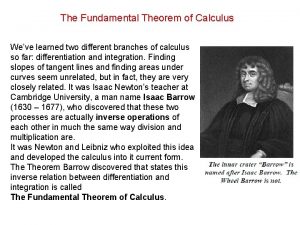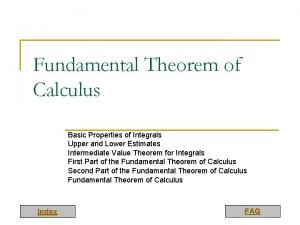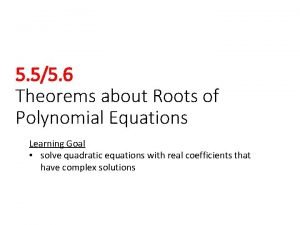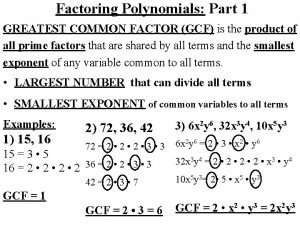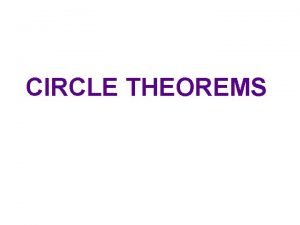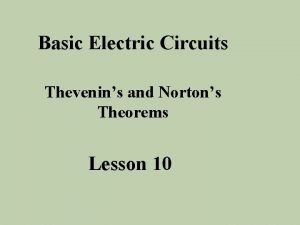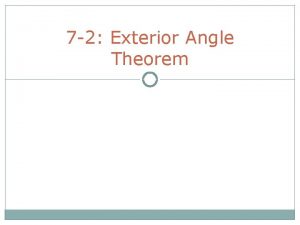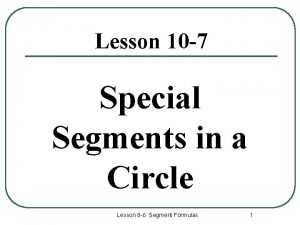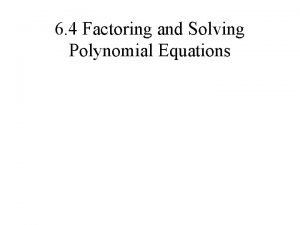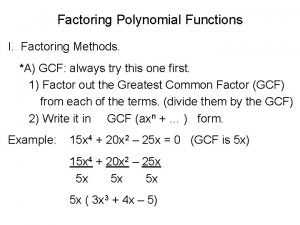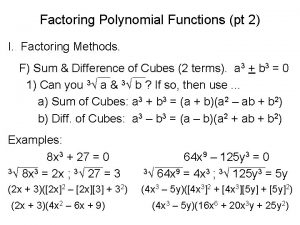Lesson 11 Polynomial Theorems Using Factoring Pre Calculus


















- Slides: 18

Lesson 11 – Polynomial Theorems – Using Factoring Pre. Calculus - Santowski 12/13/2021 Pre. Calculus - Santowski 1

Fast Five n Divide the following using (i) long division (ii) synthetic division n n (8 n 2 – 60 n – 32) / (n – 8) (b 3 + 9 b 2 + 15 b – 25) / (b + 5) (x 4 + 3 x 3 – 49 x 2 – 79 x – 54) / (x + 8) n True or False: n 12/13/2021 Pre. Calculus - Santowski 2

Lesson Objectives n Mastery of the factoring of polynomials using the algebraic processes of long & synthetic division n Introduce the remainder and rational root theorems and apply them to factor polynomials n Reinforce the understanding of the connection between factors and roots 12/13/2021 Pre. Calculus - Santowski 3

(A) Factoring Polynomials – The Remainder Theorem n So in factoring P(x), we use the remainder of the division in order to make a decision about whether or not the x – A is/is not a factor of P(x) n So if we only want to find a remainder, is there another way (rather than only division? ) n YES there is it’s called the Remainder Theorem 12/13/2021 Pre. Calculus - Santowski 4

(A) Factoring Polynomials – The Remainder Theorem n n n Divide -2 x 3 + 3 x 2 - 39 x - 20 by x + 1 Evaluate P(-1). What do you notice? What must be true about x + 1 Divide x 3 – 8 x 2 + 11 x + 5 by x - 2 Evaluate P(2). What do you notice? What must be true about (x – 2)? n Divide 2 x 3 – x 2 - 2 x + 1 by 2 x – 1 Evaluate P(½). What do you notice? What must be true about (2 x – 1)? n EXPLAIN WHY THIS WORKS? ? n n 12/13/2021 Pre. Calculus - Santowski 5

(A) Factoring Polynomials – The Remainder Theorem n Divide 3 x 3 – 4 x 2 - 2 x - 5 by x + 1 Q(x) = (3 x 2 – 7 x + 5) with a remainder of -10 Evaluate P(-1): P(-1) equals -10 n EXPLAIN WHY THIS WORKS? ? n if rewritten as: 3 x 3 – 4 x 2 - 2 x - 5 = (x + 1)(3 x 2 - 7 x + 5) - 10, P(-1) = (-1 + 1)(3(-1)2 – 7(-1) + 5) – 10 = -10 n n n 12/13/2021 Pre. Calculus - Santowski 6

(A) Factoring Polynomials – The Remainder Theorem n the remainder theorem states "when a polynomial, P(x), is divided by (ax - b), and the remainder contains no term in x, then the remainder is equal to P(b/a) n PROVE WHY THIS IS TRUE ? !? !? 12/13/2021 Pre. Calculus - Santowski 7

(B) Factoring Polynomials – The Remainder Theorem – Examples (The Basics) n Factor the following polynomials using the Remainder Theorem: n P(x) = -x 3 + 7 x – 6 P(x) = x 3 – 5 x 2 – 2 x + 24 P(x) = 2 x 3 – 3 x 2 – 3 x + 2 P(x) = x 4 – x 3 – 3 x 2 + x + 2 n n n 12/13/2021 Pre. Calculus - Santowski 8

(B) Factoring Polynomials – The Remainder Theorem - Connection n n So, from the graph on the right, determine the remainder when P(x) is divided by: (i) x + 2 (ii) x – 2 (iii) x – 4 12/13/2021 Pre. Calculus - Santowski 9

(B) Factoring Polynomials – The Remainder Theorem – Examples (Applications) n Use the remainder theorem to determine if (x – 4) is a factor of P(x) if P(x) = x 4 – 16 x 2 – 2 x + 6 n Find k so that when x 2 + 8 x + k is divided by x - 2, the remainder is 3 n Find the value of k so that when x 3 + 5 x 2 + 6 x + 11 is divided by x + k, the remainder is 3 n When P(x) = ax 3 – x 2 - x + b is divided by x - 1, the remainder is 6. When P(x) is divided by x + 2, the remainder is 9. What are the values of a and b? 12/13/2021 Pre. Calculus - Santowski 10

(C) Factoring Polynomials – the Rational Root Theorem n Our previous examples were slightly misleading … as in too easy (leading coefficient was deliberately 1) n Consider trying to factor -12 x 3 + 20 x 2 + 33 x – 20 n So in using the RTT, what values do I try n when factored -12 x 3 + 20 x 2 + 33 x – 20 becomes (2 x-1)(3 x+4)(5 -2 x) n So I would have to try x = ½, x = -4/3 and x = 5/2!!! n So, how would I know what values to try in the first place? 12/13/2021 Pre. Calculus - Santowski 11

(C) Factoring Polynomials – the Rational Root Theorem n From this example -12 x 3 + 20 x 2 + 33 x – 20 which when factored becomes (2 x-1)(3 x+4)(5 -2 x) so the roots would be ½, -4/3, and 5/2 n Make the following observation that the numerator of the roots (1, -4, 5) are factors of the constant term (-20) while the denominator of the roots (2, 3, 2) are factors of the leading coefficient (-12) n We can test this idea with other polynomials we will find the same pattern that the roots are in fact some combination of the factors of the leading coefficient and the constant term 12/13/2021 Pre. Calculus - Santowski 12

(C) Factoring Polynomials – the Rational Root Theorem n Our previous observation (although limited in development) leads to the following theorem: n Given P(x) = anxn + an-1 xn-1 + …. . + a 1 x 1 + a 0, if P(x) = 0 has a rational root of the form a/b and a/b is in lowest terms, then a must be a divisor of a 0 and b must be a divisor of an 12/13/2021 Pre. Calculus - Santowski 13

(C) Factoring Polynomials – the Rational Root Theorem n So what does this theorem mean? n If we want to factor P(x) = 2 x 3 – 5 x 2 + 22 x – 10, then we first need to find a value a/b such that P(a/b) = 0 So the factors of the leading coefficient are {+1, +2} which are then the possible values for a The factors of the constant term, -10, are {+1, +2, +5, +10} which are then the possible values for b Thus the possible ratios a/b which we can test to find the factors are {+1, +½ , +2, +5/2, +5, +10} As it then turns out, P(½) turns out to give P(x) = 0, meaning that (x – ½) or (2 x – 1) is a factor of P(x) n n 12/13/2021 Pre. Calculus - Santowski 14

(D) Factoring Polynomials – the Rational Root Theorem n Ex 1. To factor P(x) = 2 x – 9 x + 7 x + 6, what values of x Examples 3 2 could you test according to the RRT n Ex 2. To factor P(x) = 3 x 3 – 7 x 2 + 8 x – 2 what values of x could you test according to the RRT n SYNTHESIS: ex 3 Graph f(x) = 3 x 3 + x 2 - 22 x - 24 using intercepts, points, and end behaviour. Approximate turning points, max/min points, and intervals of increase and decrease. 12/13/2021 Pre. Calculus - Santowski 15

(E) Conclusion n So, we now have some “simple” algebra tools that we can use to factor polynomials n We use the rational root theorem and the remainder theorem n We use these techniques in order to determine whether a chosen binomial (ax + b) is or is not a factor of our polynomial 12/13/2021 Pre. Calculus - Santowski 16

Intermediate Value Theorem n Given p(x) = x 3 – 4 x 2 + 1, use the partial table of values to predict where the roots of p(x) would be. Explain your reasoning. 12/13/2021 Pre. Calculus - Santowski 17

Homework n Homework: n From the textbook Precalculus with Limits – A Graphing Approach (4 th ed) by Larson, Hostetler & Edwards; Sec 2. 3, p 123 -125, Q 3, 17, 23, 25, 31, 37, 41, 48, 54; APP 81; TIPS 87 12/13/2021 Pre. Calculus - Santowski 18
 Ftoc2
Ftoc2 Fundamental theorem.of calculus
Fundamental theorem.of calculus 5-5 theorems about roots of polynomial equations
5-5 theorems about roots of polynomial equations Lesson 1 factoring using the greatest common factor
Lesson 1 factoring using the greatest common factor Lesson 1 factoring using the greatest common factor
Lesson 1 factoring using the greatest common factor Honors precalculus chapter 1 test
Honors precalculus chapter 1 test Pre ap calculus quiz 1
Pre ap calculus quiz 1 Pre calculus unit 1 review
Pre calculus unit 1 review Using triangle congruence theorems
Using triangle congruence theorems Factoring by gcf
Factoring by gcf Angles within a circle
Angles within a circle Thevenin theorem examples
Thevenin theorem examples Lesson 7-2 angle theorems for triangles
Lesson 7-2 angle theorems for triangles 10-7 segments in a circle
10-7 segments in a circle Polynomial factoring rules
Polynomial factoring rules How to solve polynomial equations
How to solve polynomial equations Polynomial factoring rules
Polynomial factoring rules Matplotlib inline
Matplotlib inline How to divide a polynomial by another polynomial
How to divide a polynomial by another polynomial
